HOW MITCH PAYTON SAVED THE PRO CIRCUIT EMPIRE IN THE PANDEMIC
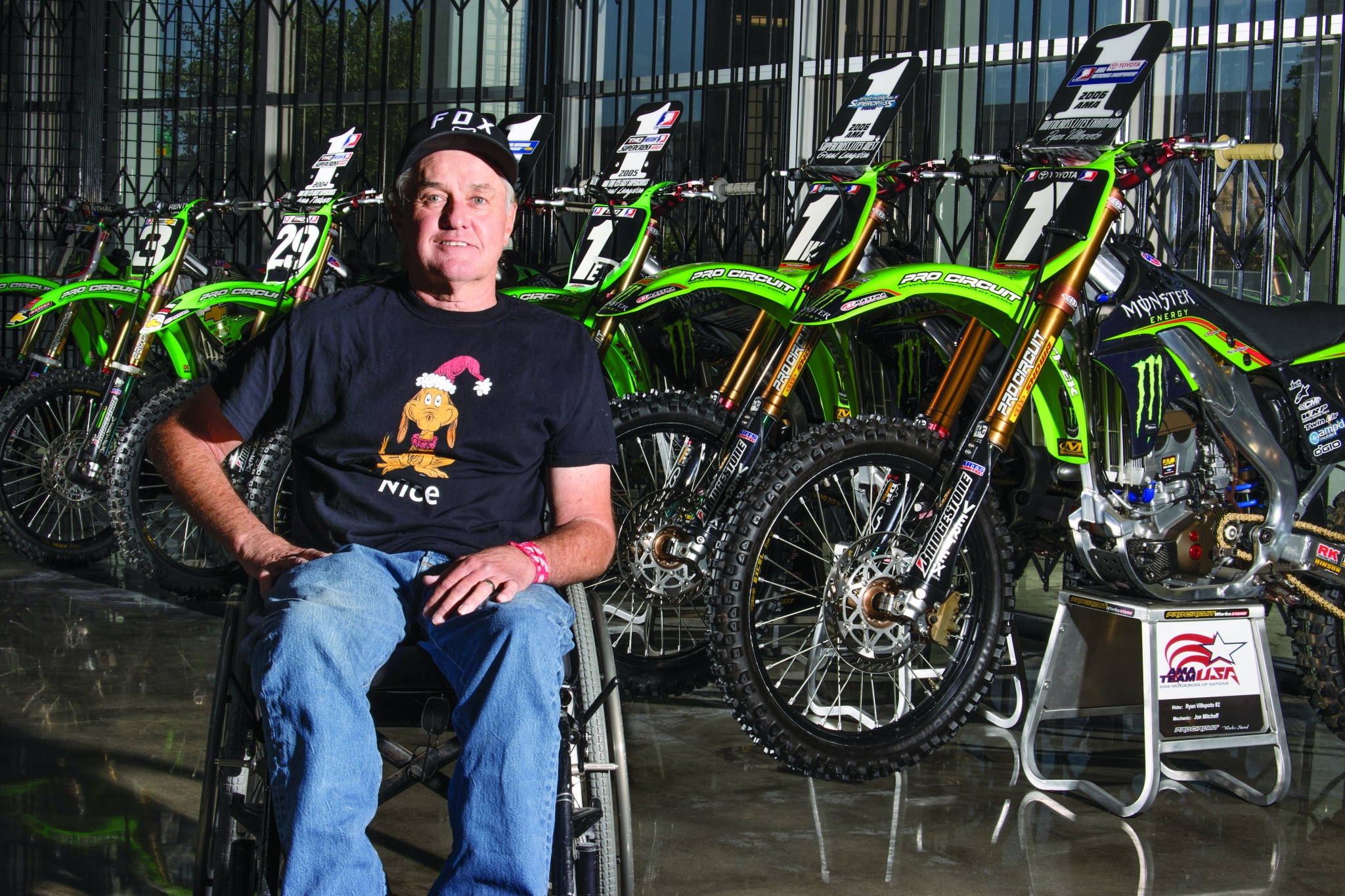 Sales for motorcycle parts have boosted since 2020, but prices for raw materials and shipping have also gone up, creating new challenges.
Sales for motorcycle parts have boosted since 2020, but prices for raw materials and shipping have also gone up, creating new challenges.
BY JOSH MOSIMAN
When the Covid-19 pandemic hit in March of 2020, many people were skeptical of how our industry would fare. Contrary to many predictions, the sport of motorcycling exploded. Dealerships sold out of new motorcycles, and used bikes sold like hot cakes. Motocross has benefited from the new riders who have joined in, and the economy is starting to open up again, but there are still lingering challenges that aftermarket company owners, like Mitch Payton, are facing each day. We sat down with the man behind Pro Circuit to learn about his experience managing the Monster Energy Pro Circuit Kawasaki team and the suspension, engine and hard-part business through the global pandemic.
WHERE WERE YOU WHEN THE PANDEMIC HIT IN MARCH OF 2020? Our mechanics were at the Indianapolis Supercross with the truck. I was at home getting ready to fly out. We knew Covid was blowing up and that we might have a limited capacity at venues for fans, but then all of a sudden Feld Motorsports called and said, “It’s done. It’s shut down.” It got deathly quiet. We didn’t lay anyone off, and the race team guys were wondering if we should be getting ready for the outdoors or Supercross. Feld Motorsports and MX Sports had an initial plan to do the outdoors and then finish the year with Supercross, but that changed.
WHAT WAS IT LIKE TO FINISH THE SERIES IN UTAH? Originally, Feld Motorsports was negotiating with Arizona to host the final rounds of the 2020 Supercross season. Then, Arizona started to spike in its Covid cases. We ended up in Salt Lake City with a Sunday, Wednesday, Sunday schedule. The guidelines were strict. Nobody was allowed in the pits. You had to wear a mask while at the facility, you had to get tested before entering the stadium, and much more. The first night we were in Salt Lake City, we saw cars turned over, a cop car on fire, people rioting, and I was like, “What is happening to this world?” I was just stoked that we were doing something, because we had been at home for three months sitting on jack stands.
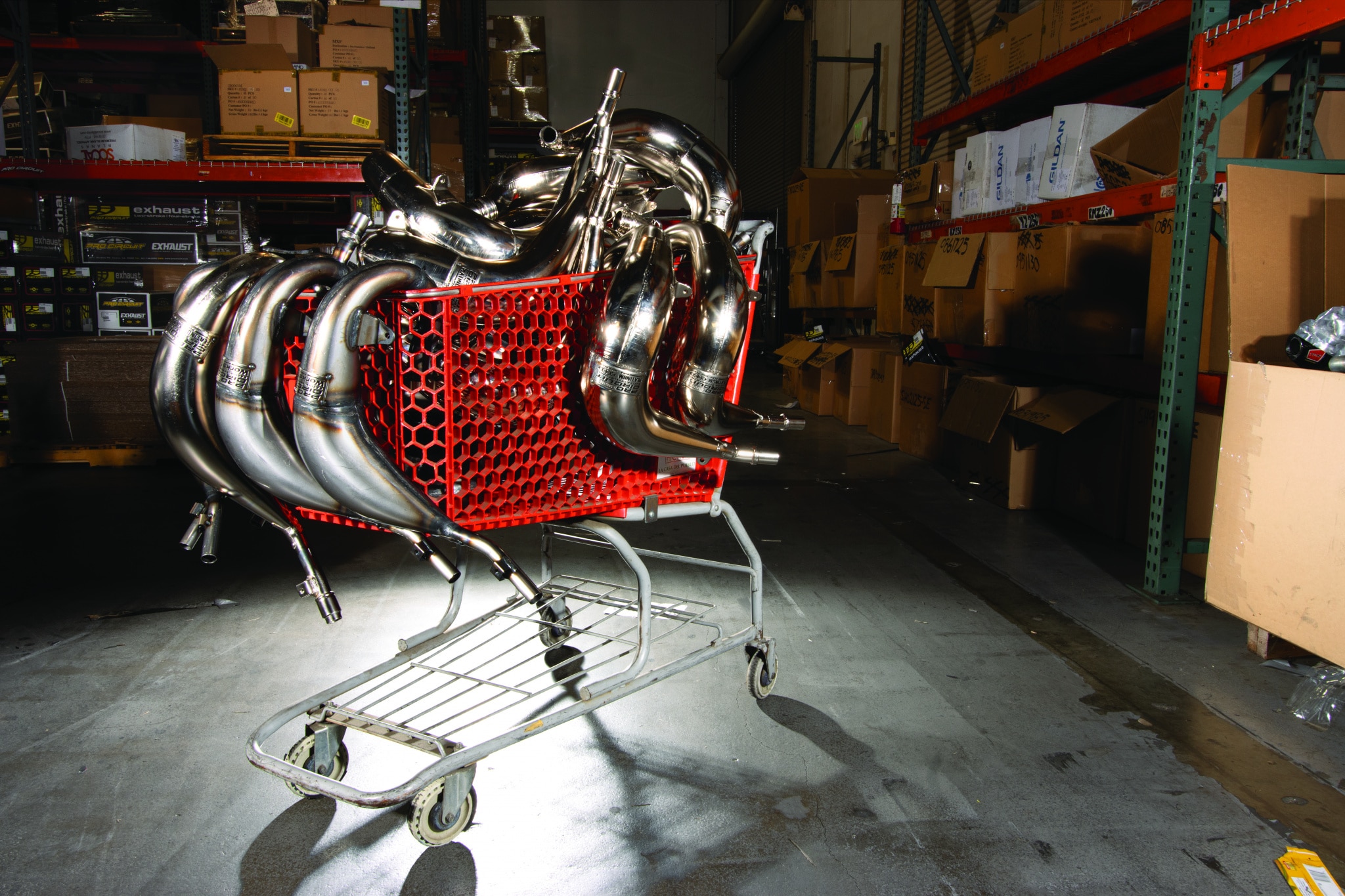 At the start of the pandemic, Mitch Payton was worried that Pro Circuit might not stay in business. Now he’s having a hard time keeping up.
At the start of the pandemic, Mitch Payton was worried that Pro Circuit might not stay in business. Now he’s having a hard time keeping up.

WAS THE INITIAL COVID SHUTDOWN TOUGH FOR BUSINESS? Definitely. We had distributors worldwide who canceled their back orders. I remember talking to my mom, and I was like, “We might lose this thing. I might go out of business.” Everyone was panicking. They wanted to hold onto their money. They didn’t want to have inventory if they couldn’t sell it. Every business tightened its belt.
WHAT WAS IT LIKE AT THE PRO CIRCUIT SHOP? We had about six to eight weeks starting from the moment when we should’ve been at Indianapolis where it was dead in the shop. Those were the bad times. I was trying to be positive. I was at the shop every day, because I had to be doing something. We had the front office closed, but the side door was open if someone needed something. We wanted to be able to help our customers and try to do the right thing, but it was shady in the beginning. Once it started to break loose, businesses could open up if they could find employees, but the government was giving away so much money that people decided to stay home and collect unemployment. To this day, that is why it’s difficult to hire anyone.
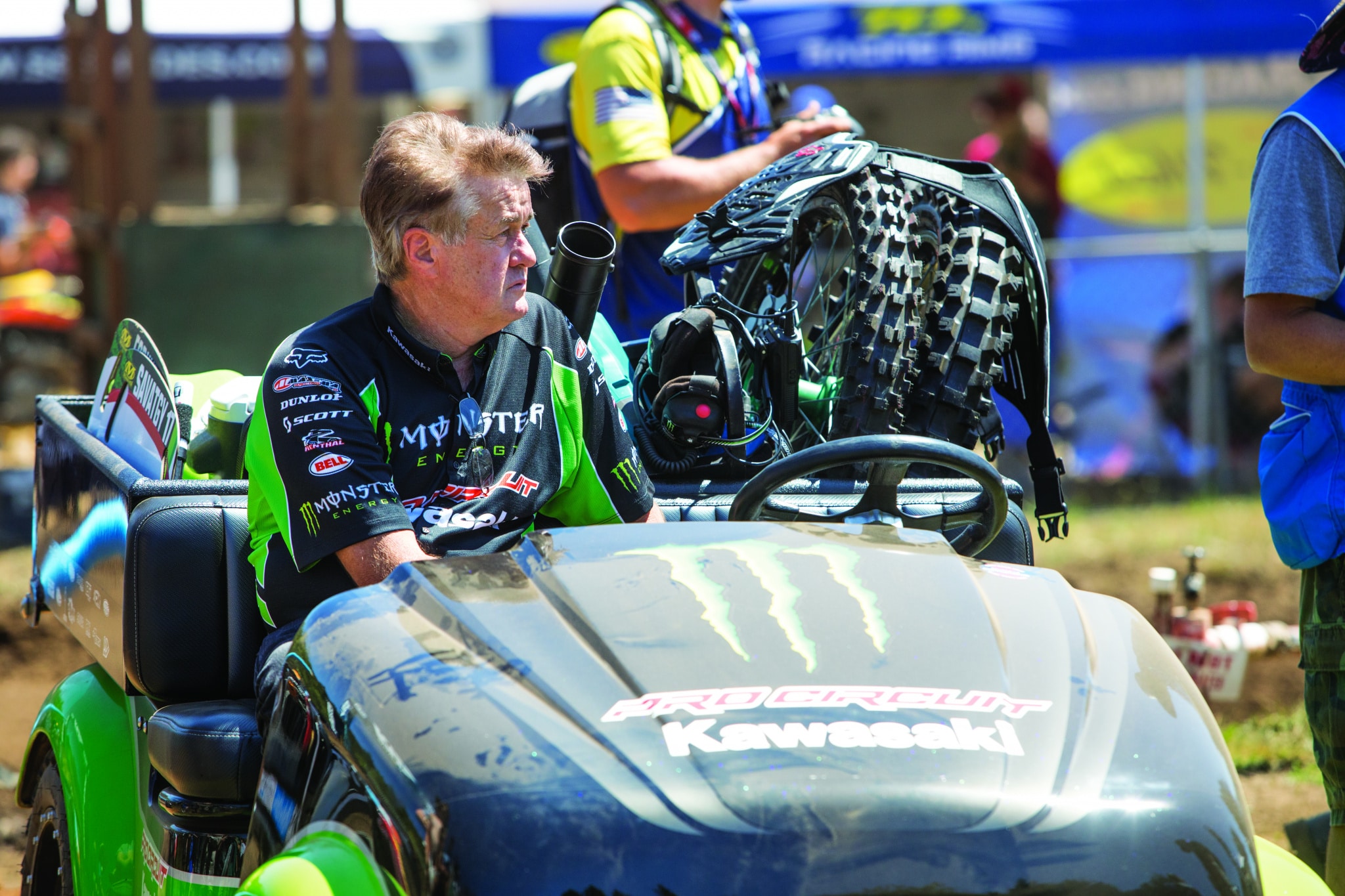 Between the Pro Circuit engine, suspension and hard-part business and the factory 250 team, Mitch stays busy.
Between the Pro Circuit engine, suspension and hard-part business and the factory 250 team, Mitch stays busy.
WHAT ABOUT WHEN THINGS OPENED UP? Once it opened up, it was crazy. A lot of machine shops had lost employees during the shutdown. Some of their workers decided to stay at home, and some of them got other jobs. Rebuilding everything has been the gnarliest part for the suppliers we deal with—and for us. The business side has been really good. There has been an explosion of new people coming into the sport. I think we’re on the cusp, I hope, of having four or five years of growth.
WHAT ARE SOME OTHER CHALLENGES PRO CIRCUIT HAS FACED? Last year when President Trump talked about a 25-percent tariff on steel from China, all the manufacturers and distributors of steel in the U.S. took that as an opportunity to raise their prices. Our two-stroke pipes, which are stamped at a friend’s factory in Ukiah, up in Northern California, went up 25 percent. He buys all of his steel from the United States, nothing from China, but he passed his steel prices on to me, and I kind of sucked that one up. Then, at the beginning of this year, the price of steel almost doubled. Now, we have vendors who tell us that aluminum has been hard to get. There are different grades of materials, and you have to think about it. Can we accept a different grade and still be okay?
“IF YOU SHIP SOMETHING IN FROM OVERSEAS, THEY TELL YOU IT’LL BE SIX TO EIGHT WEEKS FOR IT TO COME IN. THEN, THEY TELL YOU THAT YOUR SHIPMENT IS HERE, BUT IT’S NOT ON THE DOCK; IT’S PARKED IN THE HARBOR.”
WHAT ABOUT SHIPPING? It’s bad, too. If you ship something from overseas, they tell you it’ll be six to eight weeks for it to come in. Then, they tell you that your shipment is here, but it’s not on the dock; it’s parked in the harbor. They’ve got lots of product just sitting offshore in massive freighters. The dock workers got hit hard by Covid in Seattle and Long Beach, and then the Suez Canal got plugged up. It’s a challenge. If you run out of key products, you try to have them air-shipped, but then the cost is higher. If you ask vendors about expediting your orders, even offer them an extra rush fee, they laugh at you. They are so far behind that they can’t handle the load.
 One of the Pro Circuit suspension bays decorated with Pro Circuit Kawasaki number plates.
One of the Pro Circuit suspension bays decorated with Pro Circuit Kawasaki number plates.
HOW HAS THIS AFFECTED CONSUMERS? Well, Pro Circuit hasn’t raised its prices in five or six years, but we finally had to this year. You name it—aluminum, steel, stainless, titanium, rivets, packing, welding supplies and shipping have all gone up. Everything is up, up, up. You have two choices: one, raise your prices, or two, don’t sell through a distributor and go dealer direct. Those are both tough choices.
WHAT’S THE BENEFIT OF SELLING WITH A DISTRIBUTOR VERSUS DEALER DIRECT? Certain companies that go dealer direct can make their profit margin higher, but they sell less doing it. We prefer selling to our distributors—WPS, Parts Unlimited and other distributors in Europe. They do a great job of getting our products on the shelves. They have warehouses around the country. Because of that, dealers don’t stock product like they used to. Dealers stock the minimum they have to, and they count on the distributors to ship them the product the next day. In the old days, when Pro Circuit was smaller, we went dealer direct and retail, but that meant that if you were in Florida and you smashed your pipe over the weekend, you had to call on Monday to see if we had it in stock. If we did, you had to pay big money in shipping fees to get it by the next weekend.
WHICH PART OF THE BUSINESS TOOK OFF FIRST? I would say it was two things. Suspension picked up because people were going out and riding, and then we did a quick focus on pit bikes. The beauty of a KLX110, CRF110 or TTR125 is that a dad can afford one and they last forever. If you have a big backyard, three pit bikes, your buddies and some shovels, you can make a fun little track. With kids not being able to go to school, I think that parents nationwide wanted their kids to do something for fun. It happened on my street. We have a lot of neighbors who have kids, and we have a pump track at my house with lights so the kids can ride at night. We had what the kids called the “Quarantine Open.” Ryan Villopoto brought his kids. Kyle Bentley brought his kids, and we had electric Stacyc bikes for the kids to ride. We probably had 15 kids, and most of them were from my street. They all knew how to ride BMX bikes, and to them a 110 was like a works bike.
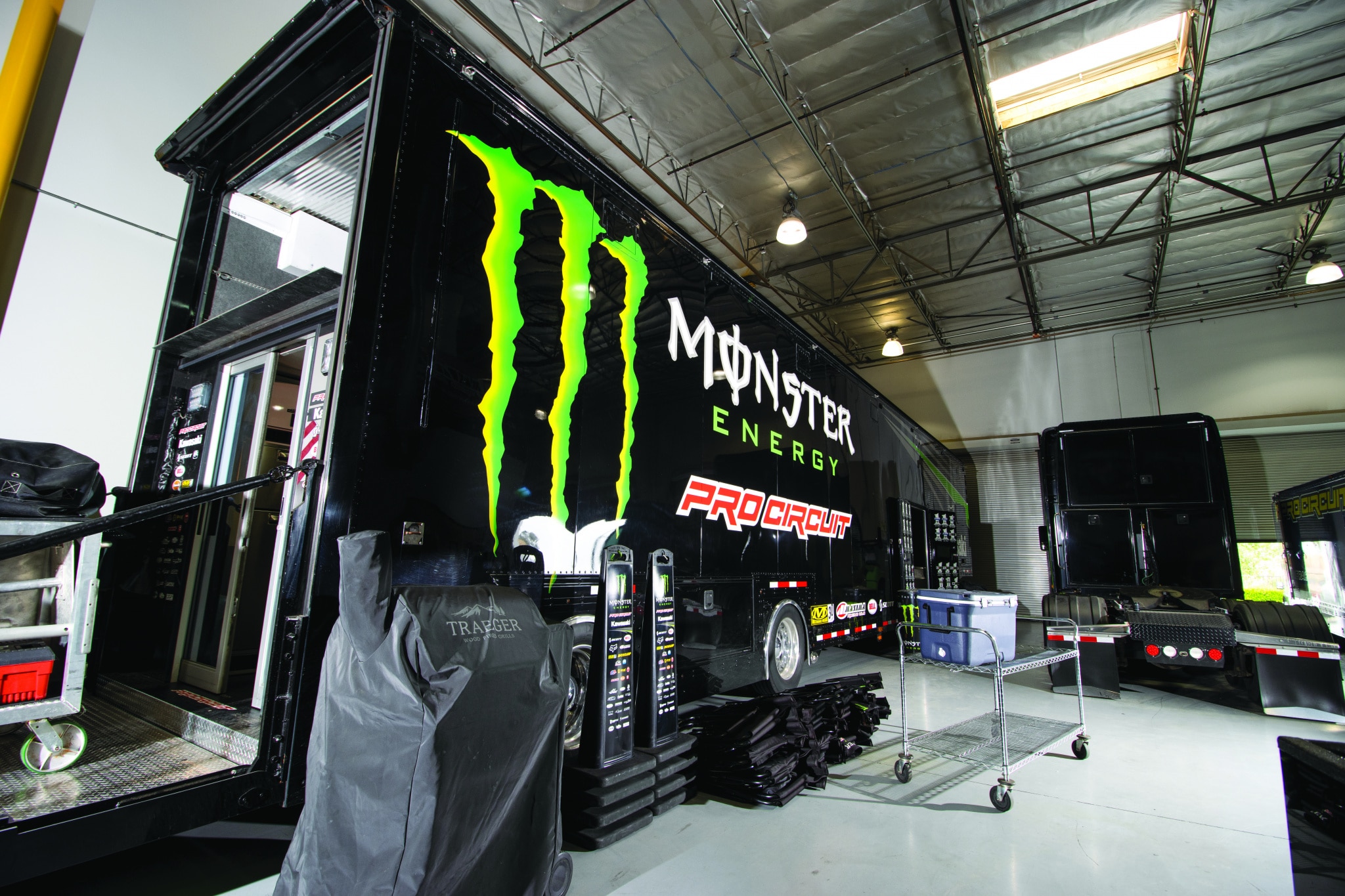 For a while, it was uncertain when the Supercross or motocross events would be able to run. Here the factory team’s semi is stored indoors at the Pro Circuit headquarters, right next to their workshop.
For a while, it was uncertain when the Supercross or motocross events would be able to run. Here the factory team’s semi is stored indoors at the Pro Circuit headquarters, right next to their workshop.
WHAT ABOUT THE INFLUX OF NEW RIDERS INTO THE SPORT? CAN WE KEEP THEM? I think that because of the lockdown, motorcycling was introduced to a lot of families who had never done it. In 2019, I had one son who played little league, one kid playing flag football and the year before one of them played basketball. Those are all stick-and-ball sports with a Friday night or Saturday game. It’s tough to do both dirt bikes and other sports. The lockdown killed stick-and-ball sports, and dirt bikes were a fun outdoor sport that the kids and parents could do together. It is possible that we might have a really healthy growth spurt for our industry.
I remember going to ride Carson Mumford’s track in the high desert last year and seeing tons of people off the side of the road parked to go riding in the desert. I was blown away. If people enjoy that, they’re not just going to stop. If there are 100,000 kids who got introduced to motorcycles and we can keep 40,000 of those, that would be sick.
HAVE YOU SEEN A BOOST IN SALES SINCE COVID HIT? Last year we had to make up for almost two months of being way off because of Covid lockdown, but then it exploded so much that 2020 was a good year. I think we’re targeting another growth year in 2021, too. The biggest problem is keeping up. There are not enough people willing to work for us to have enough manpower. Our workforce shortage is mostly in the production of pipes and hard parts.
One thing that the lockdown did was awaken an interest in rebuilding old bikes. Everybody and his brother started calling to get parts for a 1996 CR125 or 1981 RM125 or whatever they had in the garage. They were bummed that we didn’t have pipes for those bikes, but we can’t build five of something that only a handful of people want. We have to wait until the number gets big enough to attack it one product at a time. My dilemma is simple—if I could build more pipes, I would sell every one of them. It’s really just pure manpower and not enough hours in the day holding me back.
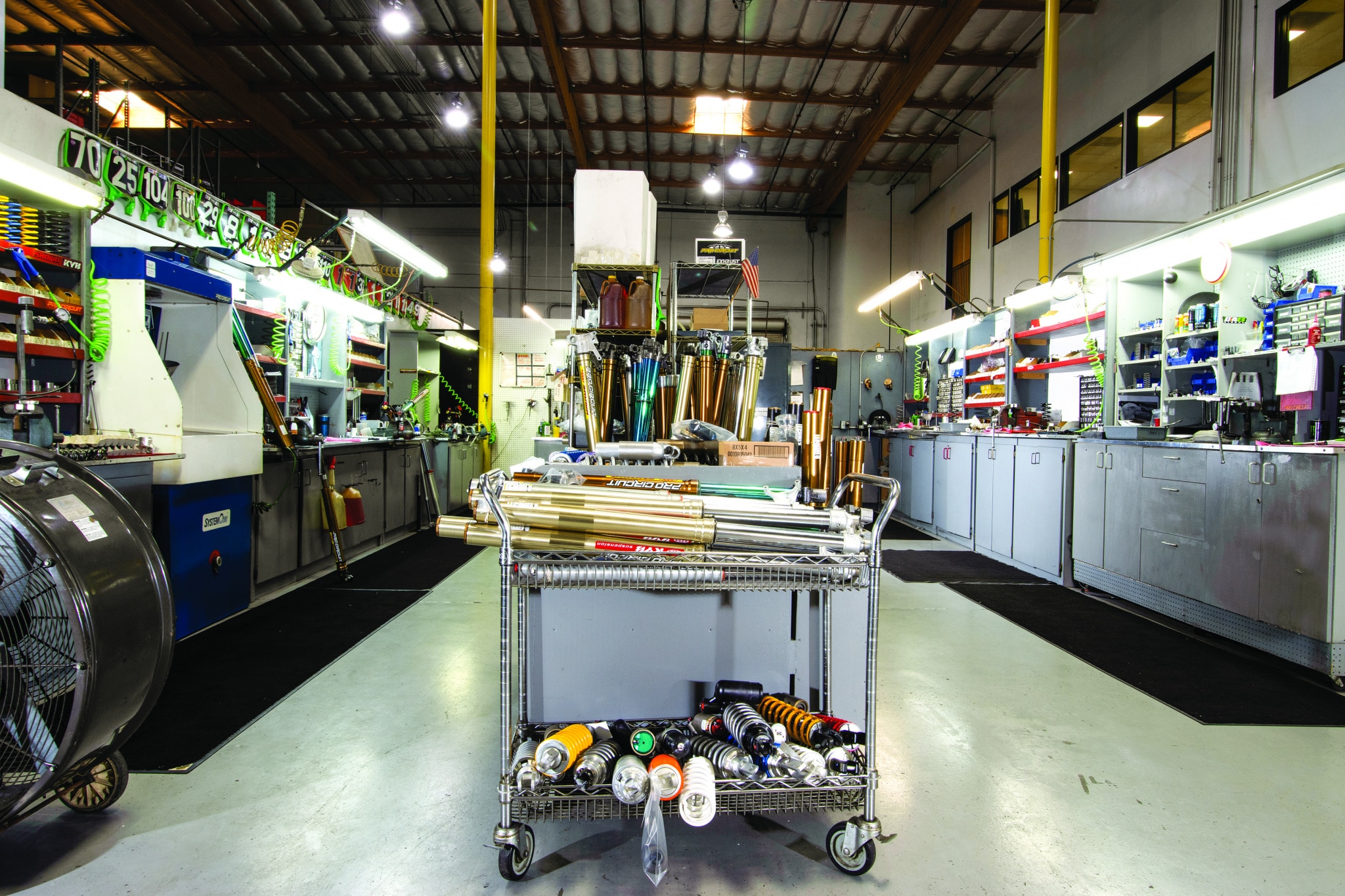 This is where the magic happens within the Pro Circuit suspension division.
This is where the magic happens within the Pro Circuit suspension division.
“I’LL PROBABLY GET IN TROUBLE FOR SAYING THIS, BUT I’M GONNA SAY IT ANYWAY. PERSONALLY, I DON’T LIKE ALL OF THESE FOUR- OR FIVE-DAY-LONG AMATEUR EVENTS.”
IS THERE SOMETHING WE CAN DO TO RETAIN OUR NEW RIDERS? I’ll probably get in trouble for saying this, but I’m gonna say it anyway. Personally, I don’t like all of these four- or five-day-long Amateur events. That’s asking a lot of a parent. How are normal working parents going to take off on Wednesday so they can get to an Amateur race on Thursday for practice (or just to find a place to park in the pits)? If you start adding up the days off of work for the parents and days off from school, it is excessive. This is the one reason my kids don’t race all the time. My wife flat out told me, “I’m not going to Glen Helen for four days in a row so they can ride a couple of motos. I don’t want to raise them that way. I want them in school.” I don’t blame her. I think it would be cooler if the kids were allowed to go to school. Even better, I wish they had a dream to be educated and could still race on the weekends.
ARE YOU TALKING ABOUT LORETTA’S OR THE LOCAL RACES? There are lots of local races that are four days long. I get Loretta Lynn’s; it is the grand finale of finales. But, week-long races are too much. Why can’t they do it like Mammoth where they run the mini bikes for a couple of days and then they shuffle the minis out and bring the big bikes in? My parents were regular people. They both worked at Rockwell International. We had one motorcycle, and we rode in the desert because it was cheaper than motocross; it was great. There’s no way my parents could have taken the time to drive me to Texas, Mammoth, Loretta’s and Ponca City. It is quickly becoming an elitist sport at the Amateur level. And it didn’t start that way. Go back and watch On Any Sunday, and see blue-collar people having fun on motorcycles.
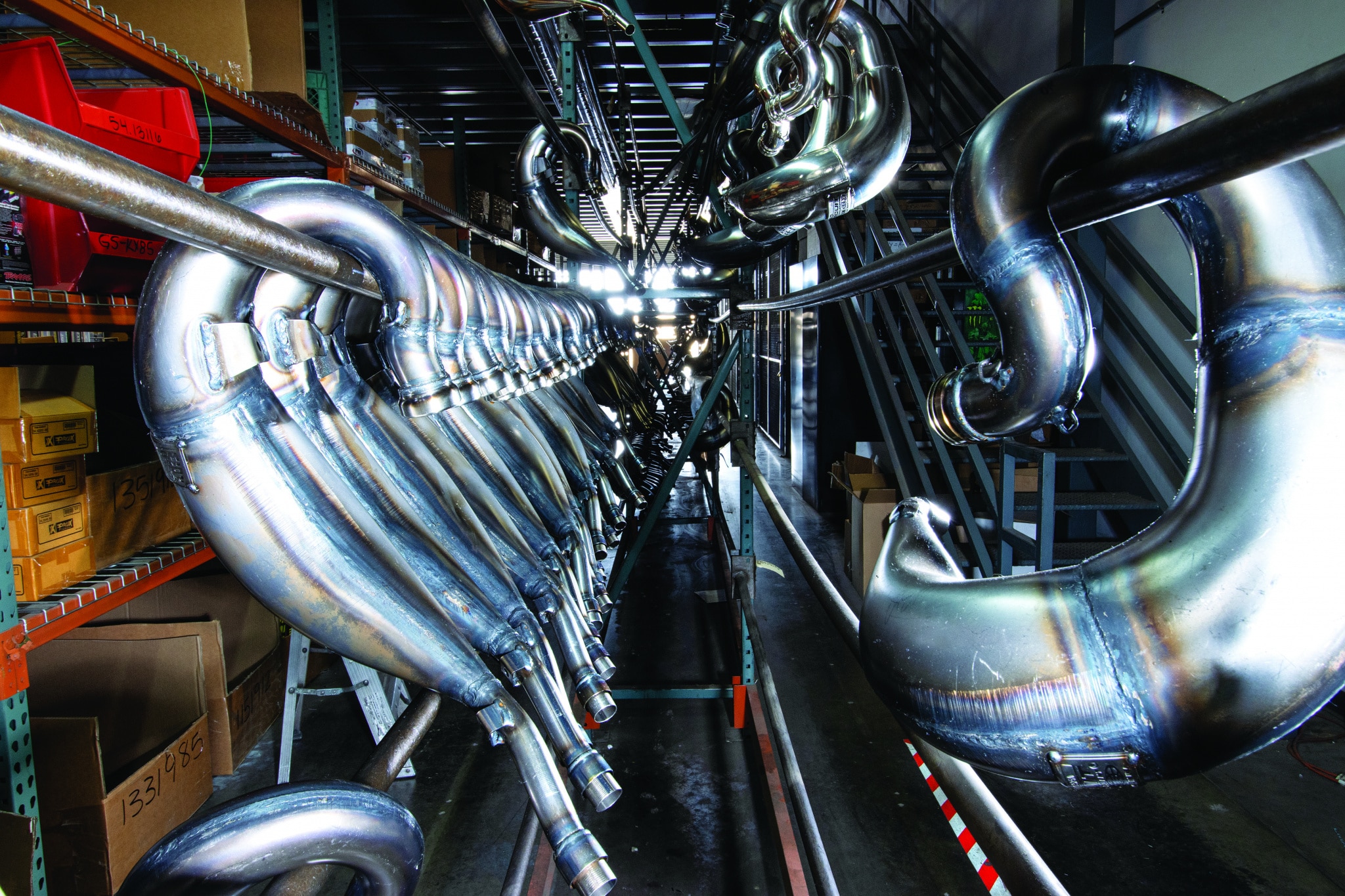 Two-strokes reigned in Supercross and motocross until four-strokes really came alive in the early 2000s. Still, Mitch Payton continues to sell lots of two-stroke pipes and products as they are growing in popularity again.
Two-strokes reigned in Supercross and motocross until four-strokes really came alive in the early 2000s. Still, Mitch Payton continues to sell lots of two-stroke pipes and products as they are growing in popularity again.
WHAT DO YOU THINK ABOUT THE ELECTRIC BIKES FOR KIDS NOWADAYS? Bring me some more hate mail. I love the fact that the Stacyc thing blew up. It literally gives kids the thrill of riding a motorcycle, but it’s small, lightweight and you have to learn how to use the throttle. From the Stacyc a kid moves to a PW50, KTM 50, CRF50 or KTM electric bike. I bought my kids two electric Husky E-5 minibikes because we respect our neighbors. I figured they could ride them whenever they wanted in the backyard. They don’t make any noise, and I don’t have to clean any air filters.
DO YOU SEE AN ELECTRIC FUTURE FOR OUR SPORT? I hope not. If there were electric bikes at Supercross, it would be extremely boring to watch. You go to MotoGP or F1 or the drags because it’s exciting to watch something fast, hear something fast and feel the vibrations. Silence is for fishing.
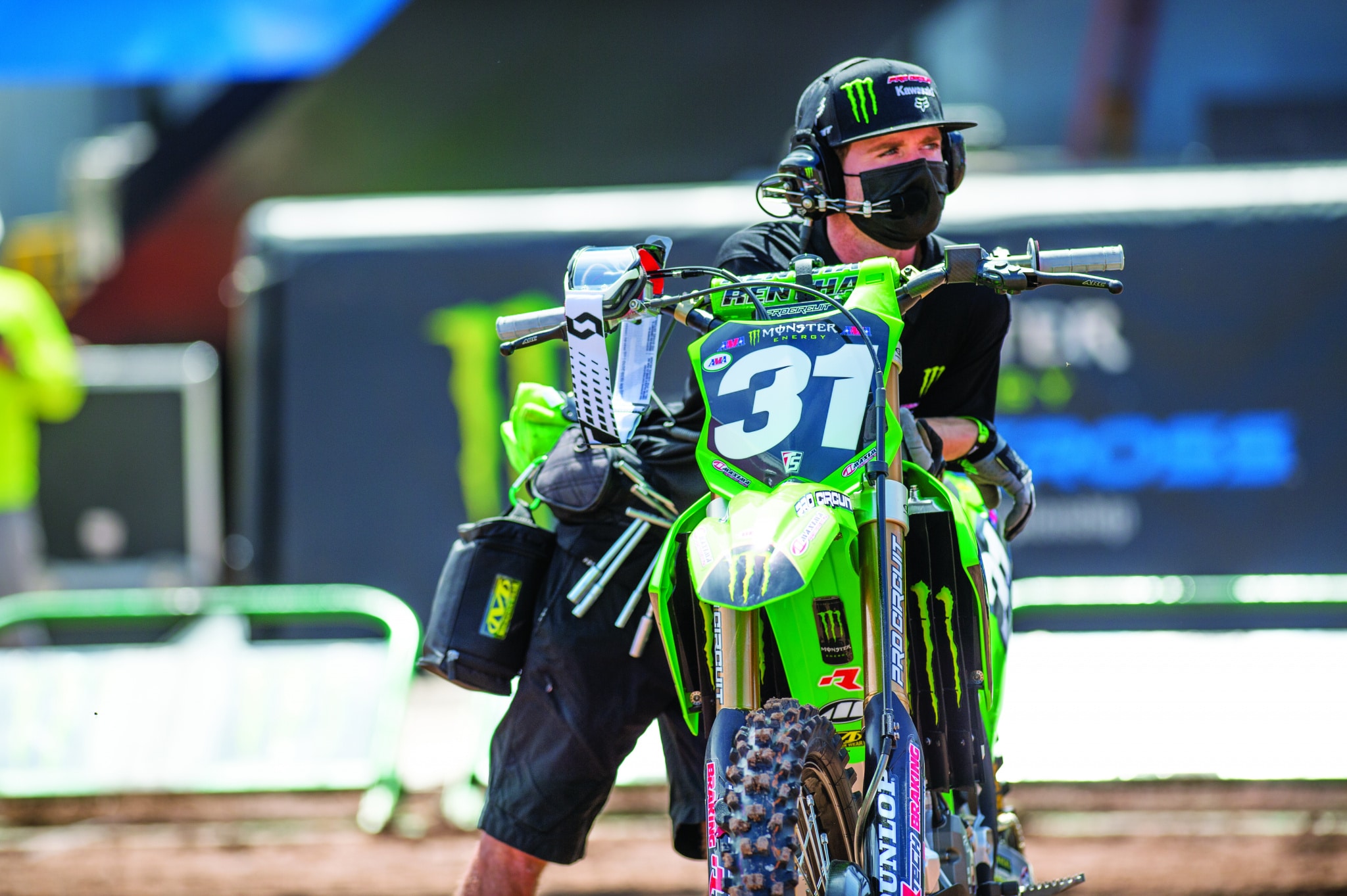 Cameron McAdoo’s mechanic Kyle Defoe guards his bike while waiting for his rider.
Cameron McAdoo’s mechanic Kyle Defoe guards his bike while waiting for his rider.
IN WHAT AREA HAS PRO CIRCUIT GROWN THE MOST SINCE COVID? I think the simple bolt-on stuff, like exhausts, are doing well, largely because the consumer can put them on by himself. I think we do a really good job with suspension and engines. We hired Luke Boyk, and he has a big background with WP Suspension working on so many different models that he’s helped make while working there. He’s made a pretty big difference for us in the suspension department. As far as engines go, we’ve stayed busy, and the uptick in two-stroke cylinders has been really good. We have 30 years of two-stroke experience, and I’ve never really seen anybody’s stuff that I couldn’t beat. We did factory stuff for a lot of teams. I think two-strokes are good for us and the sport. The four-stroke engine building side is one aspect that is a little slower. The 250 stuff is good, but 450 engine work isn’t as busy as it was in the past. They’ve improved all the 450s so much that they don’t really need more power. The Vet guys want carbon fiber, anodized parts and bling. Pro Circuit sells that, too, so everything is good.
“I’M A DIE-HARD TWO-STROKE GUY, BECAUSE THAT’S WHERE I CAME FROM. IT’S WHAT I RODE AND LEARNED HOW TO DO.”
TWO-STROKES BIKES HAVE DEFINITELY GROWN IN POPULARITY. I’m a die-hard two-stroke guy, because that’s where I came from. It’s what I rode and I learned how to do. During the first four-stroke boom, we saw a dip in two-stroke sales. The market switched to where you had to have a four-stroke. Whoever’s idea it was to make a 125 two-stroke compete against a 250cc four-stroke with double the displacement killed the 125. And then, to kick it while it was down, we had to go to unleaded fuel, and that hurt two-strokes even more. Unleaded fuel in a four-stroke was fine.
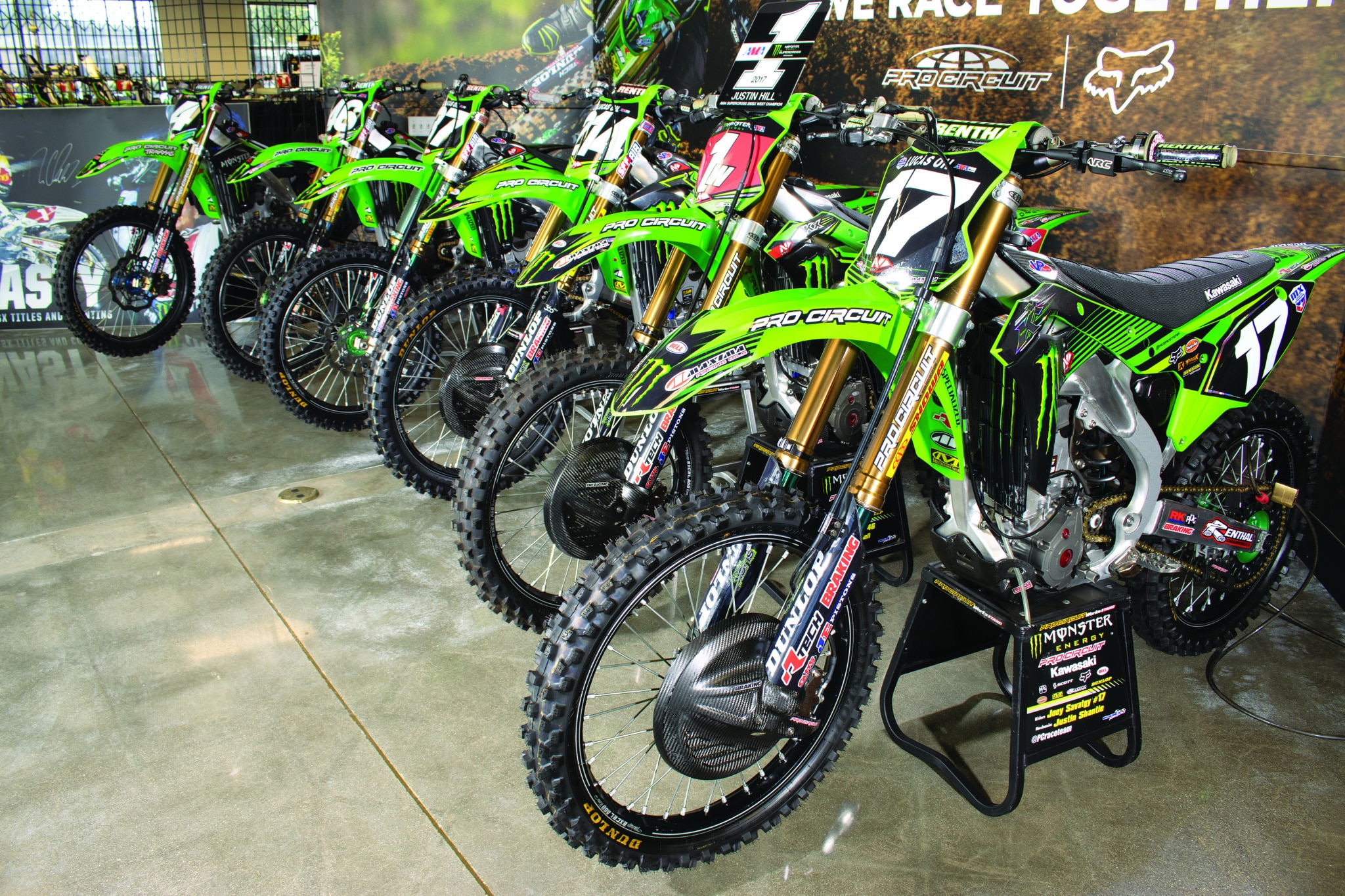 Four-strokes have come a long way since the AMA handicapped two-strokes by allowing twice the displacement for four-cycle engines.
Four-strokes have come a long way since the AMA handicapped two-strokes by allowing twice the displacement for four-cycle engines.
WHY ARE PEOPLE GOING BACK TO TWO-STROKES? Some of them had four-strokes and they said, “I can’t afford it anymore. I’m tired of spending big money.” A brand-new KTM is big money after all the fees. Speaking for the regular dudes, if they had a two-stroke before, they can buy an older two-stroke, fix it up, and that’s their baby.
WHY DID THE JAPANESE MANUFACTURERS MOVE AWAY FROM TWO-STROKES? The California Air Research Board had talked about banning two-strokes in 1999. I tried to rally some of the manufacturers to talk to them. When I called Kawasaki, they were interested in talking to the people, but when I called American Honda, they said, “No.” They agreed in the early 1960s that they would try to clean up emissions, and they wouldn’t go back on their word, but California did not ban all two-strokes in 1999. Still, that threat scared the Japanese manufacturers out of making them. So, the actual motivation for developing the four-stroke was a fake threat. I don’t think the AMA was knowledgeable enough to realize what a four-stroke could be. They were stuck in the thinking that all four-strokes were air-cooled, big-piston, dumb four-strokes like the XR650 and XR400. They couldn’t see a future where four-strokes would rev high, have a short stroke, a big bore, a lightweight crankshaft and an electronic ignition. KTM was manned by hardcore motorcycle guys, and they saw a future with both powerful four-strokes and lightweight two-strokes. That’s why they are where they are today.
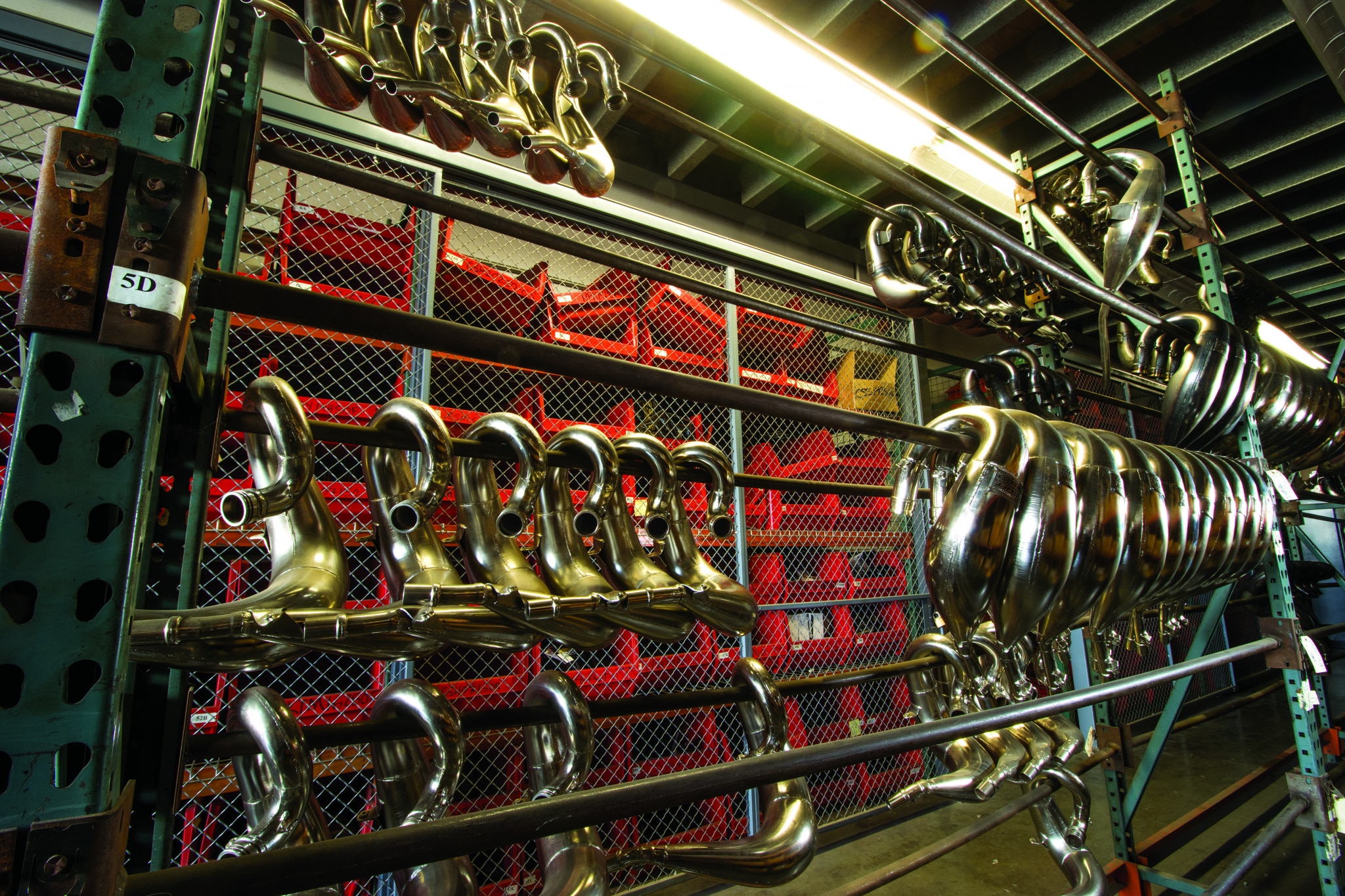 This Pro Circuit rack is usually full of pipes, but we have seen it completely empty more often than not lately. The world economy shutdown has its Pros and Cons for motocross. It brought in more riders, but also slowed down production facilities.
This Pro Circuit rack is usually full of pipes, but we have seen it completely empty more often than not lately. The world economy shutdown has its Pros and Cons for motocross. It brought in more riders, but also slowed down production facilities.
“LIFE IS GREAT. I’M DOING WHAT I’VE ALWAYS LOVED TO DO,
AND I’M HAPPY TO BE ABLE TO CONTINUE.”
HOW DO YOU FEEL NOW THAT THE PANDEMIC SCARE IS FADING? Honestly, I’m just happy. To think that there was a time when I thought we weren’t going to survive. Life is great. I’m doing what I’ve always loved to do, and I’m happy to be able to continue.





Comments are closed.